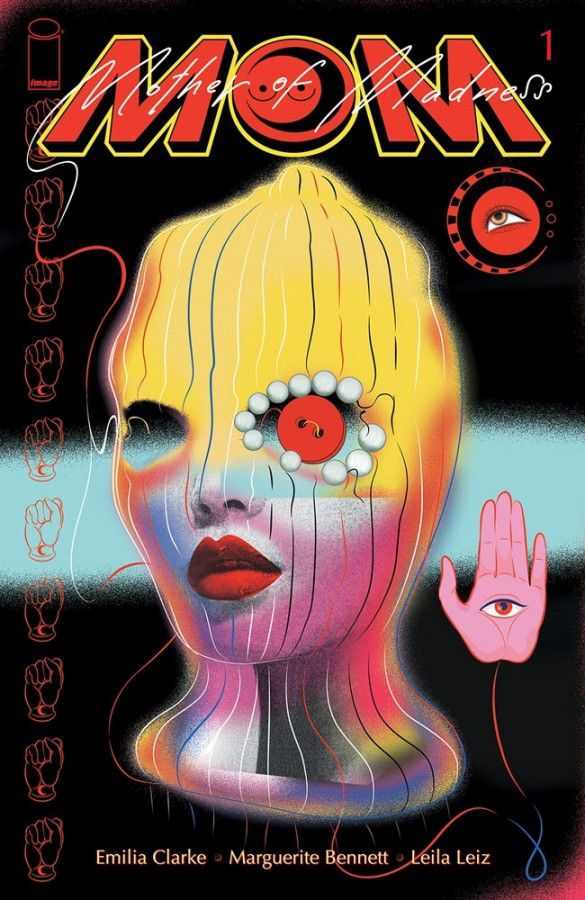Emilia Clarke wants us to talk about periods, period. On Thursday, actress turned comics writer Emilia Clarke (Game of Thrones) joined the American Library Association’s Moni Barrette at New York Comic Con to talk about creating her debut comic M.O.M.: Mother of Madness (Image Comics), about a superhero mother who first discovers her powers while on her period.
In 2021, Clarke made the surprising transition from Emmy-nominated actress to comic book author with M.O.M., co-written with Marguerite Bennett (DC Comics Bombshells) . M.O.M. tells the story of a single mother named Maya. As if being a single parent isn’t hard enough, Maya’s got superhero powers she can’t control and a job she hates. Clarke calls the series “Deadpool meets Fleabag.”
Maya is shaped by the loss of her mom at a young age and by becoming a single mother. The three-issue miniseries features a heavy dose of unpacking the different societal pressures that impact women. It’s for a younger audience (think Billie Eilish’s voice in comics form) and is a tongue-in-cheek look at navigating what it’s like to be a woman.
The actress attributed her introduction to comics to her brother, saying, “I was very much in awe of all of it but could never find my way in.” Clarke said she felt ostracized by the comics community as a young girl. Recently, however, she began to rediscover comics, and there she found the far-reaching stories and magical realms she thought were lost when she was a teenager.
Clarke said the concept for the series came from a joke in a car among friends, “Wouldn’t it be funny if there was a superhero with a costume she could pee in? That’s when the germs of this idea came about, and I started writing, and I couldn’t stop.”
Clarke worked with Bennett to develop the story, which uses a glossy pop-culture vibe to tackle feminism, friendship, and cultural issues. The all-female creative team includes illustrator Leila Leiz, co-collaborator Isobel Richardson, and cover artist Jo Ratcliffe.

For Clarke, elevating human flaws to superpowers was essential to who Maya is. It was also important for the actress to promote frank and open discussions about periods to help remove the fanfare from a common biological function. Maya’s powers depend on whatever emotions she’s feeling. The one little nibble in her powers? They only come around once a month.
Maya’s unpredictable powers help her move effortlessly from dangerous situations, like taking down a human trafficking ring, to preparing breakfast for her son. The stakes for Maya and her family rise considerably in issue #2 of M.O.M. Thankfully, she has the help of her friends. What Maya learns is that she’s a better superhero when she accepts help from others, a powerful message for young adults.
Maya’s costume was another important sticking point for Clarke. “For her outfit, I was turning to the Missy Elliott 1990s fish-eye videos and PussyRiot. There’s also science running through all her symbols and signs. We were kind of mixing chemical compound symbols and mythological symbols for feminism.”
Barrette asked Clarke about what kind of feedback she’s received from the comic. “A big fear of mine was that it would be seen as anti-man, and I didn’t want that to be the case,” Clarke said, adding, “I wanted this to be inclusive for more people. Toxic masculinity is a very real thing, and I wanted that to be in there.”
M.O.M. is about what it means to need and accept help. It’s about the relatable challenge of being a person with emotions, especially when society demonizes those who express their feelings as crazy, unstable, or unbalanced.
Asked to describe what the comic is about, Clarke said, “The story of the book is one of a kindness to one another and an openness.”
Image Comics will publish the final installment of M.O.M. on October 27, 2021.




















![[Book Review] The Blade Itself (The First Law Trilogy) by Joe Abercrombie](https://bendthekneegot.com/wp-content/uploads/2018/01/1516047103_maxresdefault-218x150.jpg)

















